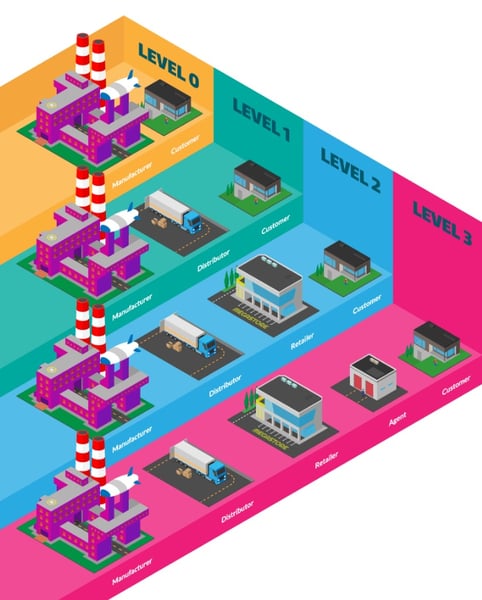
Table of Contents
- What is a distribution policy?
- Why designing it is important
- Types of distribution policies
- How to design your distribution policy
- Examples of distribution policies
What is a distribution policy?
A distribution policy is the strategy applied by a company for the correct shipment of its products from the production chain to its positioning in the market.
Distribution policies refer to the measures taken by a company, from manufacturing to packaging and final transport stages, to ensure the product reaches the most appropriate channels and points of sale; and does so within the planned launch and product replenishment times.
So, we might say that in a typical journey of a product, it passes through these hands:
- Manufacturer
- Wholesaler
- Distributor or contractor
- Seller or retailer
- Agents or reps
- Consumer
Why designing it is important
Like all processes having a lot of intermediaries, it’s important to design a good strategy to get your product into the hands of the customer quickly and avoiding bottlenecks.
Depending on your type of business and product, it may be that there are fewer phases than those we mentioned; and that, for example, you sell your catalog directly to retailers.
It doesn't matter how many people or steps there are in your distribution chain. The key is for you to define clearly in advance, how they will communicate with each other and how products will be passed on at each stage.
→ You might also try: How to ensure the success of your product distribution

Types of distribution policies
A distribution and sales policy is classified according to the number of intermediaries involved, which makes it more (or less) complex to manage.
We can distinguish five standard categories:
- Direct policy: You sell your products directly to the customer and by means of a simple strategy, as a single sales channel (that is, your own physical or online store).
- Indirect policy: You distribute your products through several intermediaries and channels.
- Intensive policy: This is the most wide-ranging strategy, as it includes a larger number of intermediaries and channels. Its degree of complexity depends on how ambitious you are: do you want to sell internationally, for which you will need diverse distributors? Will you be betting on an all-channel strategy that integrates physical and digital channels, in which case you’ll need to direct more effort towards your warehouses and contacting a large number of sellers?
- Selective policy: You only distribute your products through a limited number of channels (such as, only physical stores or only online marketplaces), or in a small geographical network (a country or a city).
- Exclusive policy: This involves you granting the distribution rights of your products exclusively to one channel or outlet. It can be your branded online store or a retailer with whom you reach an agreement. This type of distribution is common in brands with a very specific target or selling luxury products, in order to feed their image of prestige; for example, certain Bulgari jewelry that can only be found at Harrods in London.
→ Also check out: What are the key traits of today’s multichannel strategies?
How to design your distribution policy
Factors to consider:
- What kind of product it is, because if it’s made of perishable material you’ll need faster distribution to avoid accumulating expired stock. If the product is delicate or hazardous, you’ll need special insurance and transport for it.
- Where your end customers buy, whether through physical or digital channels, or both.
- Whether your product needs demonstrations and tutorials in person, by sales reps.
- Whether your product supports customization, and how you can best offer this (yourself or through another participant)
Taking your end customers into account is vital not only for helping you to understand how to reach them, but also for deciding what intermediaries you’ll need. You’ll want to offer your customers the best possible service, while maintaining efficiency and minimal costs for your company.
→ Related content: All about SKU, the essential label in distribution
Agents who can participate in a distribution and sales policy:
- Representatives: These agents can speak for your business and bring your products closer to customers, companies and/or other intermediaries. As reps are the public face of the company they should be well trained in sales goals and brand philosophy as well as familiar with the product, thus enabling them to identify opportunities for new channels of distribution or sales. They can also handle logistics and special contracts.
- Wholesalers and distributors: These are the intermediaries who purchase your products in large quantities to distribute them among other sellers or channels. Study carefully what their work networks are like and whether they will position your products in the places that interest you most.
- Retailers or Sellers: Retailers purchase products from wholesalers or distributors in order to sell them in their physical stores or through digital channels (an online store, or a marketplace dealing with a variety of brands).
- Partners: These act as sales reps, although they will not sell your product directly. It is increasingly beneficial to include marketing agents in a distribution strategy, as your partner network can act as an ambassador for your product or brand to other companies or customers.
The ideal plan starts by studying what profit margin each of these possibilities offers. Then, as much as you can afford, try different options to find out what works best with your product.
Bear in mind that selling products to individuals is not the same as selling products to other businesses.
The distribution of products for retail, with the public being the end consumer, may have a more direct distribution policy; whereas the distribution of products for businesses normally requires the participation of reps and wholesalers specializing in business services.
→ Also of interest: How to create a distribution policy on Amazon
Examples of distribution policies
Simple distribution
A brand of locally produced gluten-free biscuits in Barcelona wants to position, or find a niche for, its products. They have a limited warehouse and a handcrafted production process that does not allow them to reach large volumes of shipments.
Their focus may be on distributing their cookies to local businesses, with an indirect yet simple distribution process leading from their factory to cafes, bakeries and specialized shops in Barcelona that will sell their biscuits.
They may also be interested in employing an agent to make their brand known through newly-established local businesses and thereby gradually increase profits. This will enable the company to obtain more equipment, achieve a higher production rate, and expand distribution to other cities and across more channels (such as their own website, supermarkets and marketplaces).
Complex distribution
Consider the case of a long-established shoe manufacturer wishing to boost its international presence. To achieve this, today, it’s crucial to have a strong presence on digital channels.
This means involving more intermediaries. The manufacturer will need to have warehouses spread over a range of geographical locations to guarantee a streamlined distribution worldwide. They’ll need to build a network of wholesalers to position their products across the most suitable sales channels for footwear, as well as a network of sales personnel who are well informed about the brand and its catalog.
At Sales Layer we have helped Bobux, the world's leading brand of children's footwear, to streamline their product content management. This has had a positive impact on their digital and international distribution processes.
→ Read how Bobux improved their branded content with Sales Layer PIM
Conclusion
Your focus should be on getting fast transactions that will ensure a steady income stream.
Make sure there’s a clear communication strategy between your sales team, distributors and warehouses, to guarantee that everyone has access to the same information about product launches and stock levels, at all times.
A centralized solution like the Sales Layer PIM makes it possible for anyone you select, from inside or outside your company, to share up-to-date product data in real time.
Your best plan for a successful distribution policy starts with choosing the best advisors. Try ours for free for 30 days and see for yourself how your problems with sharing information are reduced.


.png?width=520&name=Blog%20Partner%20(1).png)




